On April 14, 2002, eight of us were on board Air China to Shanghai, including Qigong Master Qinyin (founder of Qinway Qigong), John Chen (translator) and six Qinway Qigong students. This Qigong Journey to China was sponsored by Qinway Qigong Institute and led by Qigong Master Qinyin, who grew up and was trained in China.
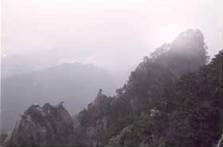 We
were to visit Mt. Jiuhua, Mt. Puto (two Buddhist holy mountains in China)
and the cultural city of Hangzhou, where Baopu Daoist Monastery is located.
The spiritual side of Qigong is intimately related to Buddhism, while the
technical side of Qigong draws heavily from Daoism. By visiting these sacred
energy sites, we were hoping to trace Qigong back to its very sources and
beyond.
We
were to visit Mt. Jiuhua, Mt. Puto (two Buddhist holy mountains in China)
and the cultural city of Hangzhou, where Baopu Daoist Monastery is located.
The spiritual side of Qigong is intimately related to Buddhism, while the
technical side of Qigong draws heavily from Daoism. By visiting these sacred
energy sites, we were hoping to trace Qigong back to its very sources and
beyond.
After about 12 hours, we descended on Pudong Airport in Shanghai, a newly built magnificent airport. The next morning, we took another flight to Huangshan Airport, still three hours away from our first destination Mount Jiuhua (left picture).
Mount Jiuhua
Jiuhua literally means "nine lotuses". Located in Anhui Province, north of Yangtze River, Mount Jiuhua covers over 100 square kilometers in area; and its main peak is 1,342 meters above sea level.
 Full
of lively peaks, wandering streams and exuberant pines and bamboos, Mount
Jiuhua attracted the Koreanprince-turned monk Qiaojue Kim, who sailed to China
in mid-Tang dynasty (618 AC - 907 AC) to advance his Buddhist practice, reclusively.
As his students increased, temples were built. Abbot Kim is known for his
sacred vow, "Until the hell is empty, I won't claim Buddhahood".
Later, he was verified by his many disciples and students as a reincarnation
of Earth Store Buddha (right picture), who specializes in saving beings
in hell. Mount Jiuhua therefore became home to Earth Store Buddha, and flourished
as a Buddhist holy mountain for more one thousand years. In its heyday, it
is said that "Scattered in the clouds and mist of Mount Jiuhua are a
thousand temples". Today, there are still 99 active temples. Many tourist
signs at Mount Jiuhua were both in Chinese and Korean, in honor of Abbot Kim.
Full
of lively peaks, wandering streams and exuberant pines and bamboos, Mount
Jiuhua attracted the Koreanprince-turned monk Qiaojue Kim, who sailed to China
in mid-Tang dynasty (618 AC - 907 AC) to advance his Buddhist practice, reclusively.
As his students increased, temples were built. Abbot Kim is known for his
sacred vow, "Until the hell is empty, I won't claim Buddhahood".
Later, he was verified by his many disciples and students as a reincarnation
of Earth Store Buddha (right picture), who specializes in saving beings
in hell. Mount Jiuhua therefore became home to Earth Store Buddha, and flourished
as a Buddhist holy mountain for more one thousand years. In its heyday, it
is said that "Scattered in the clouds and mist of Mount Jiuhua are a
thousand temples". Today, there are still 99 active temples. Many tourist
signs at Mount Jiuhua were both in Chinese and Korean, in honor of Abbot Kim.
Qiyuan Temple
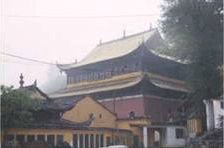 When
we arrived at Huangshan Airport, a driver from Qiyuan Temple (left picture)
was waiting for us. Qiyuan Temple is one of the oldest temples and now the
biggest at Mount Jiuhua. The name "Qiyuan" came from the place,
where, Sakyamuni Buddha, the founder of Buddhism, taught. The abbot of advanced
guest rooms for three days. Our American Qigong students were certainly eager
to experience the living of monks. We inquired about the cost of our room
& board and transportation, but did not get a clear answer. We guessed
it was donation-based.
When
we arrived at Huangshan Airport, a driver from Qiyuan Temple (left picture)
was waiting for us. Qiyuan Temple is one of the oldest temples and now the
biggest at Mount Jiuhua. The name "Qiyuan" came from the place,
where, Sakyamuni Buddha, the founder of Buddhism, taught. The abbot of advanced
guest rooms for three days. Our American Qigong students were certainly eager
to experience the living of monks. We inquired about the cost of our room
& board and transportation, but did not get a clear answer. We guessed
it was donation-based.
While we were getting to the bottom of Mount Jiuhua, suddenly Qigong Master Qinyin informed us that the earth magnetism or Qi field had significantly changed - we were already in the kingdom of Earth Store Buddha. Qigong Master Qinyin, whose lineage is more related to Mount Puto - home of Quanyin Buddha, even got a "hello" signal from Earth Store Buddha. Later, we found two interesting Quanyin temples at Mount Jiuhua, testifying to the karmic friendship between Quanyin Buddha and Earth Store Buddha.
Our dinner at the temple was believed, by most participants of our Qigong group, to be the best vegetarian food they had ever tasted. Fresh vegetables, different varieties of tofu (bean curd), along with cooking skill refined over generations, this vegetarian meal was anything but boring. A member of our Qigong group, Barbara wondered, "How could we get food of this quality in America"?
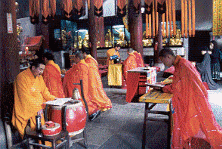 Later
that evening, we were invited to join some Buddhist activities (right picture)
in the Great Hero Hall. Three magnificent Buddhist statues stood at the center
of the hall, while dozens of monks were solemnly chanting Buddhist mantras
and scriptures. We were told that they were helping to uplift the spirits
of deceased people to better places. Some Buddhist booklets and souvenirs
were on display at a corner. You could get them by making a donation of whatever
amount. Obviously, these objects had already been energized (maybe unintentionally)
in the temple where monks practice regularly, which we could feel immediately
when we touch them.
Later
that evening, we were invited to join some Buddhist activities (right picture)
in the Great Hero Hall. Three magnificent Buddhist statues stood at the center
of the hall, while dozens of monks were solemnly chanting Buddhist mantras
and scriptures. We were told that they were helping to uplift the spirits
of deceased people to better places. Some Buddhist booklets and souvenirs
were on display at a corner. You could get them by making a donation of whatever
amount. Obviously, these objects had already been energized (maybe unintentionally)
in the temple where monks practice regularly, which we could feel immediately
when we touch them.
The Abbot was glad to meet with our Qigong group. In our mind, an abbot of such a big temple must be an old man. Surprisingly, he only looked in his 30s. Appearance can be misleading, though. Regular Buddhist practice, which entails energy work just like Qigong, may bring rejuvenation. On the other hand, it also shows that when the old Abbot chose his successor, good understanding and spiritual achievement was emphasized over seniority. This was confirmed when Qigong Master Qinyin commented in private that "This young Abbot was already high-leveled. He takes care of three big temples, yet, his mind is always as calm as a flat lake". He has the ability to separate this spirit from his body already. Unfortunately, the Abbot did not have time to give us a talk or seminar. This lesson would be made up when we came to Mount Puto.
Sky Counter
Before 5am, the next morning, noises woke us. Apparently, the temple had already stirred. Monks and supporting staff were getting ready for their morning lesson and routines. Amazingly, we didn't feel tired after getting up so early. Maybe the mountain energy helped. After having a satisfactory Chinese breakfast, we set off to Sky Counter, the summit of Mt. Jiuhua.
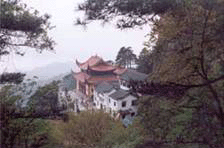 First, we took a 10 minute chairlift. Along the way up, we enjoyed an encompassing
view of Mt. Jiuhua, half covered in clouds and mists. We passed through sharp
cliffs while vibrant forests towered above. Finally, we arrived at Bow-to-sutra
Counter (see left picture) first, where Earth Store Buddha is believed to
have studied Buddhist scriptures, respectfully. We also saw two giant footprints
on a rock, which belong to Earth Store Buddha as well. After we burned incense
and paid our respect to this temple, we discovered Qigong Master Qinyin mysteriously
missing. After about 15 minutes, she emerged from nowhere, holding a big bracelet
in her hand. Qigong Master Qinyin told us that while she was in the temple
bowing, an old monk (probably the Abbot) took her aside and gave her the bracelet
he had used to practice for the past few decades. An intense energy aura has
formed around the bracelet. The old monk disclosed that he got a signal from
Earth Store Buddha that he needed to give this bracelet as a gift to Qigong
Master Qinyin.
First, we took a 10 minute chairlift. Along the way up, we enjoyed an encompassing
view of Mt. Jiuhua, half covered in clouds and mists. We passed through sharp
cliffs while vibrant forests towered above. Finally, we arrived at Bow-to-sutra
Counter (see left picture) first, where Earth Store Buddha is believed to
have studied Buddhist scriptures, respectfully. We also saw two giant footprints
on a rock, which belong to Earth Store Buddha as well. After we burned incense
and paid our respect to this temple, we discovered Qigong Master Qinyin mysteriously
missing. After about 15 minutes, she emerged from nowhere, holding a big bracelet
in her hand. Qigong Master Qinyin told us that while she was in the temple
bowing, an old monk (probably the Abbot) took her aside and gave her the bracelet
he had used to practice for the past few decades. An intense energy aura has
formed around the bracelet. The old monk disclosed that he got a signal from
Earth Store Buddha that he needed to give this bracelet as a gift to Qigong
Master Qinyin.
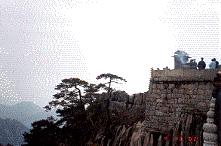 The road to Sky Counter (right picture) was made of steep steps of stone,
with a few pavilions scattered in between. Reaching the peak, we saw a huge
inscription on the rock, which read "Non Human World". Apparently,
this was a place where you would temporarily forget the human world. It was
ideal for transcendental Buddhist practice. There was a "Sky Counter
Temple" on the top, where Earth Store Buddha is believed to once live.
We noticed that all temples at Mt. Jiuhua were in a special yellow color,
while all residential buildings were white or at least non-yellow. Temple
roofs edged upwards in gracious curves. On top of Sky Counter, we were now
entitled to a sky view of Mt. Jiuhua. As an old saying goes, "At Mount
Jiuhua, there are 99 peaks with names and 99 peaks without names". All
these peaks were now meandering underneath us, each with a unique shape. Some
were capped with temples in yellow, contrasting sharply with green mountains
and white clouds.
The road to Sky Counter (right picture) was made of steep steps of stone,
with a few pavilions scattered in between. Reaching the peak, we saw a huge
inscription on the rock, which read "Non Human World". Apparently,
this was a place where you would temporarily forget the human world. It was
ideal for transcendental Buddhist practice. There was a "Sky Counter
Temple" on the top, where Earth Store Buddha is believed to once live.
We noticed that all temples at Mt. Jiuhua were in a special yellow color,
while all residential buildings were white or at least non-yellow. Temple
roofs edged upwards in gracious curves. On top of Sky Counter, we were now
entitled to a sky view of Mt. Jiuhua. As an old saying goes, "At Mount
Jiuhua, there are 99 peaks with names and 99 peaks without names". All
these peaks were now meandering underneath us, each with a unique shape. Some
were capped with temples in yellow, contrasting sharply with green mountains
and white clouds.
Quanyin Peak
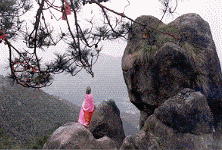 On
our way down Sky Counter, we were led to Quanyin Peak (left picture). Through
a video, we already knew that there was a cave near Quanyin Peak, where the
famous modern Ch'an (Zen) lineage holder The Empty Cloud (Xuyun) Abbot (1839-1959)
once practiced. Unfortunately, this cave was closed due to construction. Yet,
a special karmic meeting was ready to unfold in front of us.
On
our way down Sky Counter, we were led to Quanyin Peak (left picture). Through
a video, we already knew that there was a cave near Quanyin Peak, where the
famous modern Ch'an (Zen) lineage holder The Empty Cloud (Xuyun) Abbot (1839-1959)
once practiced. Unfortunately, this cave was closed due to construction. Yet,
a special karmic meeting was ready to unfold in front of us.
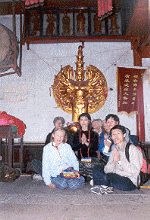 The name of "Quanyin Peak" came from a rock on this peak that resembles
Quanyin Buddha overlooking Mount Jiuhua. Long ago, someone asked for Quanyin
Buddha's help and made a wish. When his request was fulfilled, he dedicated
a white robe to this rock. An ancient Quanyin Temple was built near this site.
The temple is not big, with only one main hall. Besides a Quanyin statue at
the center, there was also a one-thousand-arm Quanyin Buddha (right picture)
on one side of the wall. "One-thousand-arms" are just a visible
representation of Quanyin Buddha's unlimited power and compassion. Many of
us got fortune sticks in this temple, which were then interpreted by monks.
The name of "Quanyin Peak" came from a rock on this peak that resembles
Quanyin Buddha overlooking Mount Jiuhua. Long ago, someone asked for Quanyin
Buddha's help and made a wish. When his request was fulfilled, he dedicated
a white robe to this rock. An ancient Quanyin Temple was built near this site.
The temple is not big, with only one main hall. Besides a Quanyin statue at
the center, there was also a one-thousand-arm Quanyin Buddha (right picture)
on one side of the wall. "One-thousand-arms" are just a visible
representation of Quanyin Buddha's unlimited power and compassion. Many of
us got fortune sticks in this temple, which were then interpreted by monks.
It turned out that the abbot wasn't home. Since he was visiting temples in a different province, one of his disciples toured the temple with us. He led us to a shed outside, where his master, the abbot, practices. In the corner of the shed, there was a small booth, only big enough for one person to stand or sit. "The abbot often meditates when he doesn't have much to do", the disciple explained. Qigong Master Qinyin commented, "This is called 'Un-falling Meditation' (Bu Dao Dan), where practitioner meditates day and night without lying down to sleep. It is really a high level practice". Qigong Master Qinyin then took a chance to meditate in this booth.
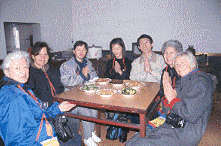 The disciple explained that he had followed the abbot for many years, and
witnessed many of the abbot's extraordinary spiritual powers. For decades,
the abbot has been practicing Quanyin methods and later Amitabha methods.
The disciple showed us a business card of the abbot with a picture of him
(we discovered that abbots at Mount Jiuhua usually have cell phones - modern
communication even has its impact in deep Buddhist mountains). He pointed
to us an inverted miniature of Quanyin Buddha at the abbot's throat. Everyone
in our group was surprised by what we saw. Apparently, by practicing Quanyin
methods, one may acquire Quanyin nature.
The disciple explained that he had followed the abbot for many years, and
witnessed many of the abbot's extraordinary spiritual powers. For decades,
the abbot has been practicing Quanyin methods and later Amitabha methods.
The disciple showed us a business card of the abbot with a picture of him
(we discovered that abbots at Mount Jiuhua usually have cell phones - modern
communication even has its impact in deep Buddhist mountains). He pointed
to us an inverted miniature of Quanyin Buddha at the abbot's throat. Everyone
in our group was surprised by what we saw. Apparently, by practicing Quanyin
methods, one may acquire Quanyin nature.
For this auspicious meeting, the disciple gladly invited us to have lunch at the temple. In the dining room, we saw vegetables lying on the floor in corners (not refrigerated!), and they burned wood (not gas or electricity!) to cook dishes. The result was a fragrant vegetarian meal, which impressed our mouths as well as minds.
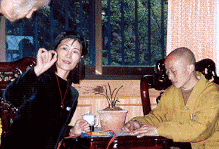 After lunch, we went to a meeting room upstairs to have tea. We had such a
congenial talk with the disciple that he decided to give Qigong Master Qinyin
(Qinway Qigong Institute) a special gift
- a relic believed to be from Quanyin Buddha. The disciple explained that
the relic came from a big Buddhist Ceremony dedicated to Quanyin Buddha. At
the ceremony, relics just fell down like rain drops on an altar. The disciple
added that he had carried these relics for years. They grew in size as he
paid respect to them regularly.
After lunch, we went to a meeting room upstairs to have tea. We had such a
congenial talk with the disciple that he decided to give Qigong Master Qinyin
(Qinway Qigong Institute) a special gift
- a relic believed to be from Quanyin Buddha. The disciple explained that
the relic came from a big Buddhist Ceremony dedicated to Quanyin Buddha. At
the ceremony, relics just fell down like rain drops on an altar. The disciple
added that he had carried these relics for years. They grew in size as he
paid respect to them regularly.
Incarnation Hall
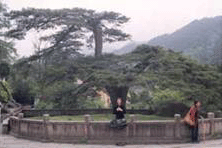 After our unforgettable experiences at Quanyin Temple, we took cable car down
the hill. It was already in the afternoon, and we were headed to the renowned
Incarnation Hall, dedicated to Earth Store Buddha's holy body. Along the way,
we stopped by the famed Phoenix Pine (left picture), and recharged ourselves
(right picture) in the Qigong state while waiting for our private bus to come.
After our unforgettable experiences at Quanyin Temple, we took cable car down
the hill. It was already in the afternoon, and we were headed to the renowned
Incarnation Hall, dedicated to Earth Store Buddha's holy body. Along the way,
we stopped by the famed Phoenix Pine (left picture), and recharged ourselves
(right picture) in the Qigong state while waiting for our private bus to come.
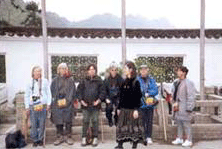
When Abbot Kim (reincarnated Earth Store Buddha) passed away at the age of 99, his disciples kept his body in an urn. When they opened the urn after three years, his body was still in a good shape without any sign of decay. This was an indication he had achieved enlightenment or become Buddha. Thus a time-honored tradition started at Mount Jiuhua. When monks passed away, their bodies would be kept in urns (right picture below) for three years (instead of being buried or cremated) to see if they could stand the test. Not all of them did.
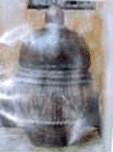
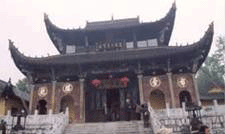 The moment I stepped into the Incarnation Hall (left picture), I felt a strong
magnetic pulling force that seemed to come from underground. We looked around,
hoping to see Earth Store Buddha's "gold body" (It is called "gold
body" because gold won't decay, and these bodies are often gold-coated
too). Of course, we didn't find it, as a monk told us it was kept in a cellar
underground. In the beginning, a tower was built upon the cellar housing Earth
Store Buddha's body. Later, a temple was built to cover the tower, which became
known as "The Incarnation Hall". We did standing Qigong meditation
in this fabulous hall for 15 minutes.
The moment I stepped into the Incarnation Hall (left picture), I felt a strong
magnetic pulling force that seemed to come from underground. We looked around,
hoping to see Earth Store Buddha's "gold body" (It is called "gold
body" because gold won't decay, and these bodies are often gold-coated
too). Of course, we didn't find it, as a monk told us it was kept in a cellar
underground. In the beginning, a tower was built upon the cellar housing Earth
Store Buddha's body. Later, a temple was built to cover the tower, which became
known as "The Incarnation Hall". We did standing Qigong meditation
in this fabulous hall for 15 minutes.
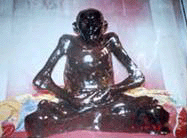 After
leaving Incarnation Hall, we stopped by another temple, which houses a modern
"gold body" (left picture). He passed away only in the 1980s. It
was said that over one hundred gold bodies appeared in Mount Jiuha's history,
but only a few survived the destructive Cultural Revolution (1966 - 1976).
These gold bodies stood as silent testimonials attesting to what Buddhist
practices can really achieve, especially enlightenment. Perhaps it was their
intention, too, to leave their bodies behind as good examples to encourage
Buddhist practices.
After
leaving Incarnation Hall, we stopped by another temple, which houses a modern
"gold body" (left picture). He passed away only in the 1980s. It
was said that over one hundred gold bodies appeared in Mount Jiuha's history,
but only a few survived the destructive Cultural Revolution (1966 - 1976).
These gold bodies stood as silent testimonials attesting to what Buddhist
practices can really achieve, especially enlightenment. Perhaps it was their
intention, too, to leave their bodies behind as good examples to encourage
Buddhist practices.
This concluded our first full day at Mount Jiuhua. We came to Qiyuan Temple for dinner and rested in the evening.
Airborne Quanyin Temple
The next day, our Qigong group
again woke at
Centennial Palace
Next we came to Centennial Palace, named after Abbot Wuxia ("Flawless", see picture below) who lived there until 1623, when he died at the age of 126. As Barbara wrote, "I noticed a great joy arising from within myself as I stood looking at the gold-coated body of this well-loved monk. I felt I must have known him". Many stories are associated with this legendary monk. Every twenty days, he used drops of blood from his tongue to copy 81 Buddhist scriptures (and he still lived to 126 years old!) These precious scriptures are still kept at a nearby museum. In Qing dynasty (1644 - 1911), Centennial Palace caught fire, and monks tried to carry his body out. It was just too heavy. Apparently, Abbot Wuxia was not willing to leave the temple. So monks knelt down before him, "If you don't want to go, then we will all have to stay here and die". As soon as this sentence was finished, Abbot Wuxia's immortalized body turned its arms downward and rain poured down extinguishing the fire. The arms remain in this downward position to this date.
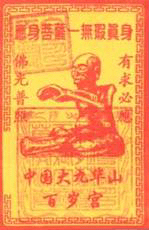 As Centennial Palace's fame grew and attracted more and more monks, more bowls
were needed. Once, Abbot Wuxia's spirit appeared at Jing De Zheng, a famous
ceramic town in China. An old monk meditated in front of a ceramic factory
7 days and 7 nights without speaking. Factory people asked, "How much
money do you need to build your temple?" The old monk said, "I don't
want any money. I just need a pen to write on a bowl and make it in your furnace".
When the furnace was opened, surprisingly all bowls carried the inscription
"Centennial Palace, Mount Jiuhua", and there were total 8,400 of
them. When these bowls were brought to Centennial Palace, they couldn't find
the monk who ordered it. Actually, it was against the tradition of Mount Jiuhua
that monks leave the mountain to ask for donation. Then, the factory people
saw Abbot Wuxia's gold body with exactly the same feature as the old monk
who ordered these bowls. They all bowed down in awe.
As Centennial Palace's fame grew and attracted more and more monks, more bowls
were needed. Once, Abbot Wuxia's spirit appeared at Jing De Zheng, a famous
ceramic town in China. An old monk meditated in front of a ceramic factory
7 days and 7 nights without speaking. Factory people asked, "How much
money do you need to build your temple?" The old monk said, "I don't
want any money. I just need a pen to write on a bowl and make it in your furnace".
When the furnace was opened, surprisingly all bowls carried the inscription
"Centennial Palace, Mount Jiuhua", and there were total 8,400 of
them. When these bowls were brought to Centennial Palace, they couldn't find
the monk who ordered it. Actually, it was against the tradition of Mount Jiuhua
that monks leave the mountain to ask for donation. Then, the factory people
saw Abbot Wuxia's gold body with exactly the same feature as the old monk
who ordered these bowls. They all bowed down in awe.
Near Centennial Palace, there is a Five Hundred Arhat Hall, which houses five hundred gold-plated statues of arhats (beings whose spiritual levels are between Buddha and humanity). Each of them has a very different clothing, posture and facial expression. Qigong Master Qinyin explained that they were first generation students of Buddhism, fortunate enough to learn Buddhism directly from founder Sakyamuni Buddha.
Jiuhua Street
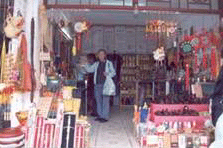 In
the afternoon, our Qigong group enjoyed free time to explore Jiuhua Street
(left picture). Hundreds of similar shops along the street offer endless varieties
of Buddhist supplies and local produce (right picture below). We stepped into
a big shop, which served us tea and free samples of produce. The most famous
local herb at Mount Jiuhua is Huang Jing (Yellow Essence), which is said to
have been used by Earth Store Buddha and later Abbot Wuxia for Bigu (Qigong
energized-fasting) and spiritual practice, when food wasn't readily available.
We were surprised to find an internet bar on Jiuhua Street. Some of us sent
e-mails back to America.
In
the afternoon, our Qigong group enjoyed free time to explore Jiuhua Street
(left picture). Hundreds of similar shops along the street offer endless varieties
of Buddhist supplies and local produce (right picture below). We stepped into
a big shop, which served us tea and free samples of produce. The most famous
local herb at Mount Jiuhua is Huang Jing (Yellow Essence), which is said to
have been used by Earth Store Buddha and later Abbot Wuxia for Bigu (Qigong
energized-fasting) and spiritual practice, when food wasn't readily available.
We were surprised to find an internet bar on Jiuhua Street. Some of us sent
e-mails back to America.
 While
we wanted to stay and enjoy more about Mount Jiuhua, our schedule dictated
we leave the next day. Many of us talked about returning to Mount Jiuhua in
three years. By that time, a 99 meter high statue of Earth Store Buddha will
have been completed as a new landmark.
While
we wanted to stay and enjoy more about Mount Jiuhua, our schedule dictated
we leave the next day. Many of us talked about returning to Mount Jiuhua in
three years. By that time, a 99 meter high statue of Earth Store Buddha will
have been completed as a new landmark.
The City of Hangzhou
Early morning, our Qigong group got on the bus again. After about 6 hours, we arrived at Hangzhou, capital of Zhejiang Province in the southeast of China. Hangzhou was once the capital of China, especially in the South Song dynasty (1127 AC - 1279 AC). As a Chinese saying goes, "Above is heaven, and down on earth are Suzhou and Hangzhou". Indeed, in the eyes of Chinese people, Hangzhou is a heaven on earth.
West Lake
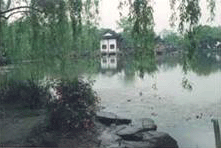 After
settling down at Xinxin hotel, we found out that our hotel was only steps
away from the renowned West Lake (left picture) and we enjoyed a perfect view
from our windows. Our first tour the next morning was West Lake, where we
boarded a boat.
After
settling down at Xinxin hotel, we found out that our hotel was only steps
away from the renowned West Lake (left picture) and we enjoyed a perfect view
from our windows. Our first tour the next morning was West Lake, where we
boarded a boat.
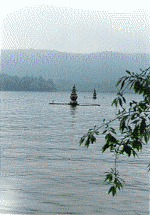 West
Lake covers a body of water of about 5.66 square kilometers. Three sides of
West Lake are surrounded by mountains or hills, while one side opens to the
city of Hangzhou. By chance or design, two of Chinaís most important poets,
Bai Juyi and Su Dongpuo, were mayors of Hangzhou. Each of them built a dike
in West Lake, which came to be known as Bai Dike and Su Dike, respectively.
Three islands in West Lake create additional dynamics and scenes. For hundreds
of years, perhaps tens of thousands of poems have been written about the beauty
of West Lake by the best poets China has ever produced.
West
Lake covers a body of water of about 5.66 square kilometers. Three sides of
West Lake are surrounded by mountains or hills, while one side opens to the
city of Hangzhou. By chance or design, two of Chinaís most important poets,
Bai Juyi and Su Dongpuo, were mayors of Hangzhou. Each of them built a dike
in West Lake, which came to be known as Bai Dike and Su Dike, respectively.
Three islands in West Lake create additional dynamics and scenes. For hundreds
of years, perhaps tens of thousands of poems have been written about the beauty
of West Lake by the best poets China has ever produced.
Our boat brought us to one of these islands, called "Three Ponds Reflecting the Moon" ( right picture). Near this island, three pagodas form an equilateral triangle in the lake, a perfect geometrical beauty. Classical pavilions, zip-zapping corridors, ancient tablets and calligraphies melt into nature almost without notice. Floating upon West Lake brought a profound tranquility on them, just like this scenic flat lake. It appeared that all urban noises were at least a thousand miles away.
Tiger Spring and Dragon Well
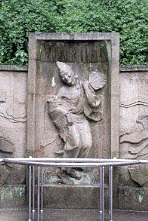 Our
next destination was Tiger Spring, one of the three major springs in China.
In the Tang dynasty (618- 907), a monk came here and wanted to build a temple
on hillside. This site was perfect in all aspects, except the lack of water
supply. A dream came to him that two tigers would come to dig up a spring.
When he woke the next morning, he did see two tiger running outside and a
clear spring welled up. Ever since then, the spring is called Tiger Spring,
and the temple Tiger Spring Temple. Tiger Spring Temple also houses museums
of Ji Gong (an ancient chivalrous monk that is a household name in China,
see left picture) and Abbot Hongyi (a modern artist-turned Buddhist). Their
presence obviously contributes enormously to the spiritual field at this temple.
Our
next destination was Tiger Spring, one of the three major springs in China.
In the Tang dynasty (618- 907), a monk came here and wanted to build a temple
on hillside. This site was perfect in all aspects, except the lack of water
supply. A dream came to him that two tigers would come to dig up a spring.
When he woke the next morning, he did see two tiger running outside and a
clear spring welled up. Ever since then, the spring is called Tiger Spring,
and the temple Tiger Spring Temple. Tiger Spring Temple also houses museums
of Ji Gong (an ancient chivalrous monk that is a household name in China,
see left picture) and Abbot Hongyi (a modern artist-turned Buddhist). Their
presence obviously contributes enormously to the spiritual field at this temple.
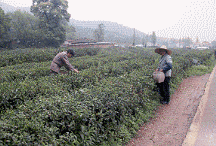 Next,
our Qigong group stopped by the Dragon Well area, where the famed Dragon Well
tea is produced. Dragon Well tea is one of the top ten teas in China, produced
only in Hangzhou, actually only a small area near Dragon Well. April is already
a season for plucking tea. Tea peasants stand in the Tea Field (right picture),
and pluck only those tiny tender leaves. What manual work. These tea leaves
are then be manually stir-fried and curled up into rolls. We got a chance
to drop in a tea peasantís home to taste authentic, new Dragon Well tea. All
tea leaves spread out again after hot water was poured into the tea cups.
The taste was truly fragrant, pleasant and refreshing.
Next,
our Qigong group stopped by the Dragon Well area, where the famed Dragon Well
tea is produced. Dragon Well tea is one of the top ten teas in China, produced
only in Hangzhou, actually only a small area near Dragon Well. April is already
a season for plucking tea. Tea peasants stand in the Tea Field (right picture),
and pluck only those tiny tender leaves. What manual work. These tea leaves
are then be manually stir-fried and curled up into rolls. We got a chance
to drop in a tea peasantís home to taste authentic, new Dragon Well tea. All
tea leaves spread out again after hot water was poured into the tea cups.
The taste was truly fragrant, pleasant and refreshing.
Spirits' Retreat Temple
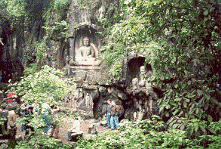 Our
second full day in Hangzhou started at Spirits' Retreat Temple, located in
the mountainous area northwest of West Lake. Spirits' Retreat Temple was built
in 326 AC, more than 1,600 years ago, by an Indian monk Huili, who thought
spirits retreated in these mountains of striking elegance.
Our
second full day in Hangzhou started at Spirits' Retreat Temple, located in
the mountainous area northwest of West Lake. Spirits' Retreat Temple was built
in 326 AC, more than 1,600 years ago, by an Indian monk Huili, who thought
spirits retreated in these mountains of striking elegance.
Airborne Peak (left picture) stands in front of Spirits' Retreat Temple like a natural fence. Only 209 meters above sea level, it looked particularly small among mountains, almost "airborne". On Airborne Peak, there are as many as 338 statues of Buddha carved out of rock, the earliest completed in 951 AC. Each of these statues has a unique appearance. The largest one is the famous Laughing Buddha, the Buddha of the future world. This peak is really a collection of treasures.
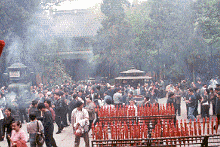 Spirits' Retreat Temple consists of Heaven King Hall, Great Hero Hall, Medicine
Buddha Hall and Five Hundred Arhat Hall, all in magnificent scales. In the
main Great Hero Hall, sits Sakyamuni Buddha at the center with Quanyin Buddha
in the back, which is a typical layout. We saw a jade statue of sleeping Buddha
from Burma -- an exquisite piece of art. Spirits' Retreat Temple (right picture)
is busy at most times. Pious pilgrims come here all year long to pay respect,
burn incense, and make dedications.
Spirits' Retreat Temple consists of Heaven King Hall, Great Hero Hall, Medicine
Buddha Hall and Five Hundred Arhat Hall, all in magnificent scales. In the
main Great Hero Hall, sits Sakyamuni Buddha at the center with Quanyin Buddha
in the back, which is a typical layout. We saw a jade statue of sleeping Buddha
from Burma -- an exquisite piece of art. Spirits' Retreat Temple (right picture)
is busy at most times. Pious pilgrims come here all year long to pay respect,
burn incense, and make dedications.
Embrace-simplicity Daoist Monastery
So far, all of sites we visited in this tour seemed to be Buddhist. As a Qigong group, this may not be fair, since Qigong draws heavily from Daoism. Hence, we devoted one afternoon to visit Embrace-simplicity Daoist Monastery (left picture below), located on a mountain ridge overlooking West Lake.
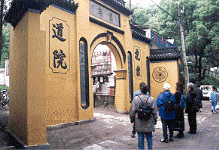 Although
there are many similarities between Buddhism and Daoism, differences are also
many. The ultimate goal of Buddhism is enlightenment, or the ascension of
spirits, and it cares less about health and longevity for this lifetime. Also
it is against Buddhist principles to show powers of special abilities unless
for the benefit of public. On the other hand, although Daoism pursues immortality
as well, it also emphasizes health and longevity through specific techniques
in this lifetime. In short, Buddhism gives Qigong a spiritual dimension while
Daoism greatly enriches the technical contents of Qigong.
Although
there are many similarities between Buddhism and Daoism, differences are also
many. The ultimate goal of Buddhism is enlightenment, or the ascension of
spirits, and it cares less about health and longevity for this lifetime. Also
it is against Buddhist principles to show powers of special abilities unless
for the benefit of public. On the other hand, although Daoism pursues immortality
as well, it also emphasizes health and longevity through specific techniques
in this lifetime. In short, Buddhism gives Qigong a spiritual dimension while
Daoism greatly enriches the technical contents of Qigong.
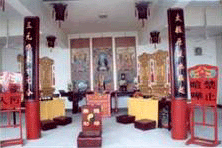 Embrace-simplicity Monastery was named after its founder, Ge Hong (317-420),
who called himself Baopu Zi (Embrace-simplicity Master). Ge Hong was an important
contributor in the development of Chinese Daoism, particularly alchemy. His
work, "Inner Book of Embrace-simplicity Master" remains
a Daoist Qigong classic today. This ridge, where his monastery is located,
became known "Ge Ridge". For decades, Ge Hong practiced Daoism and
alchemy here. At the peak of Ge Ridge, there is still a mesa, where Ge Hong
supposedly refined Qigong elixirs. Due to an unfortunate fire a few years
ago, the monastery is still undergoing a major renovation, while the Grand
Hall (right picture) has been rebuilt. Standing at the monastery's balcony
offers an elevated panoramic view of the peaceful West Lake. No wonder Ge
Hong chose here to practice.
Embrace-simplicity Monastery was named after its founder, Ge Hong (317-420),
who called himself Baopu Zi (Embrace-simplicity Master). Ge Hong was an important
contributor in the development of Chinese Daoism, particularly alchemy. His
work, "Inner Book of Embrace-simplicity Master" remains
a Daoist Qigong classic today. This ridge, where his monastery is located,
became known "Ge Ridge". For decades, Ge Hong practiced Daoism and
alchemy here. At the peak of Ge Ridge, there is still a mesa, where Ge Hong
supposedly refined Qigong elixirs. Due to an unfortunate fire a few years
ago, the monastery is still undergoing a major renovation, while the Grand
Hall (right picture) has been rebuilt. Standing at the monastery's balcony
offers an elevated panoramic view of the peaceful West Lake. No wonder Ge
Hong chose here to practice.
Compared with Spirits' Retreat Temple, considerably less people came here to pay respect. Apparently, Buddhism shows more compassion for the suffering of all sentient beings and hence maintains a closer touch with Chinese populace. Although "merits and virtues" are also very important in Daoism, Daoists tend to practice in solitude and try less to reach out to the public. However, Daoist techniques developed for cultivating body/mind/spirit over thousands of years are undoubtedly a profound treasure. Now, Qigong is bringing the best of Buddhist and Daoist practices to China and the whole world.
Mount Puto
Finishing our tour in Hangzhou, our Qigong group set off to Mount Puto in the morning. After taking a bus and then a boat for several hours, we arrived at Mount Puto, a mountainous coastal island covering an area of about 13 sq kilometers. Mount Puto is known for its "numerous temples, strange rocks, golden beaches, tide sound, and mirages".
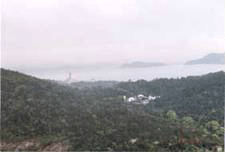 Mount Puto (left picture) became known as a Buddhist holy site as early as
859 AC, when a Japanese monk Huier brought a Quanyin statue from Mount Wutai
(another Buddhist holy mountain in north China) and was sailing back to Japan.
However, his ship couldn't go any further when passing through Mount Puto.
He tried several times in vain. Huier decided that this was the place that
Quanyin Buddha wanted to stay. A farmer donated a house and the first Quanyin
temple was thus built on Puto Island with the name "Unwilling-to-leave
Quanyin Temple". Ever since then, Mount Puto became home to Quanyin Buddha.
Many temples on this island are dedicated to Quanyin Buddha. In its hey day,
there were about 100 temples and over 4,000 monks and nuns living on this
small island.
Mount Puto (left picture) became known as a Buddhist holy site as early as
859 AC, when a Japanese monk Huier brought a Quanyin statue from Mount Wutai
(another Buddhist holy mountain in north China) and was sailing back to Japan.
However, his ship couldn't go any further when passing through Mount Puto.
He tried several times in vain. Huier decided that this was the place that
Quanyin Buddha wanted to stay. A farmer donated a house and the first Quanyin
temple was thus built on Puto Island with the name "Unwilling-to-leave
Quanyin Temple". Ever since then, Mount Puto became home to Quanyin Buddha.
Many temples on this island are dedicated to Quanyin Buddha. In its hey day,
there were about 100 temples and over 4,000 monks and nuns living on this
small island.
Puto Buddhist College (Nunnery)
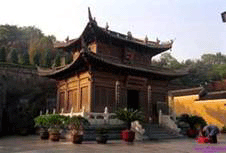 Through Zhejiang Buddhist Association, we were lucky to stay at Puto Buddhist
College (Nunnery) on a peak. There are about 40 nun students in this college
and temple. There is a beautiful uphill garden in the back of the nunnery.
From there, you may enjoy sunrise and sunset, and a remarkable panorama of
Mount Puto. Near the garden, there is a new temple made exclusively of bronze
(which imitates the appearance of wood), supposedly the largest Bronze Temple
(left picture) in China.
Through Zhejiang Buddhist Association, we were lucky to stay at Puto Buddhist
College (Nunnery) on a peak. There are about 40 nun students in this college
and temple. There is a beautiful uphill garden in the back of the nunnery.
From there, you may enjoy sunrise and sunset, and a remarkable panorama of
Mount Puto. Near the garden, there is a new temple made exclusively of bronze
(which imitates the appearance of wood), supposedly the largest Bronze Temple
(left picture) in China.
Abbess and Assistant Abbess warmly received us and invited us to join their morning lesson, which also started at 5am every morning. (We were awakened by morning services at Mount Jiuhua, but didnít participate).
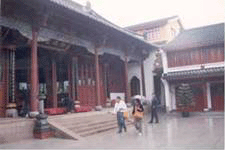 Next morning, at about 4:40am, bell chiming started to resonate in a slow
rhythm throughout the temple. "It is time to get up!" Dozens of
nuns seemed to pop up from nowhere and entered The Main Hall (left picture)
in a row. Our Qigong group stood at the end of line, since we are "lay
people". Right before
Next morning, at about 4:40am, bell chiming started to resonate in a slow
rhythm throughout the temple. "It is time to get up!" Dozens of
nuns seemed to pop up from nowhere and entered The Main Hall (left picture)
in a row. Our Qigong group stood at the end of line, since we are "lay
people". Right before
For many of us, this was our first
time witnessing a live morning lesson in a Buddhist temple, although we had
been to many temples on this tour. Nuns stood in several rows in the temple,
all in a solemn mood. One nun served as a solo, and another played musical
instruments while all the others chanted Buddhist classics continuously without
reading from books. I thought they must have memorized everything by heart
since they did essentially the same morning lesson seven days a week. For
50 minutes, the nuns chanted sutras and praised the many Buddhas. I recognized
some of them, but not all. Then nuns started to walk slowly in circles in
the temple, while still chanting non-stop. The ceremony stopped at 6am. Time
for breakfast. Nuns quietly left the temple towards the dining hall, a short
walk's distance  .
Assistant Abbess let us take a look at the nuns eating breakfast, although
we would have our own breakfast in separate quarters. This was the most solemn
breakfast we had even seen. Nuns sat in about ten rows in the spacious dinning
hall, while three nuns on duty brought dishes to their tables. During this
food distribution process, nuns were chanting Buddhist scriptures, too, instead
of casual talk. Assistant Abbess assured us that although meal was served,
nuns could eat as much as they like. Actually, about a dozen of them were
practicing "no-food-after-lunch", an indication of their abilities
to connect with universal energy.
.
Assistant Abbess let us take a look at the nuns eating breakfast, although
we would have our own breakfast in separate quarters. This was the most solemn
breakfast we had even seen. Nuns sat in about ten rows in the spacious dinning
hall, while three nuns on duty brought dishes to their tables. During this
food distribution process, nuns were chanting Buddhist scriptures, too, instead
of casual talk. Assistant Abbess assured us that although meal was served,
nuns could eat as much as they like. Actually, about a dozen of them were
practicing "no-food-after-lunch", an indication of their abilities
to connect with universal energy.
Puji Temple
 After
breakfast, our first target was Puji Temple, the biggest and most famous temple
on Mount Puto. This temple was first built in 916 AD and had been renovated
and rebuilt several times in the past thousand years.
After
breakfast, our first target was Puji Temple, the biggest and most famous temple
on Mount Puto. This temple was first built in 916 AD and had been renovated
and rebuilt several times in the past thousand years.
In front to the temple, there is a large Let-go Pond (left picture). As Buddhism cherishes all sentient beings, often there is a let-go pond near a temple, where captured fishes or turtles can be released. The size of the let-go pond usually reflects the size of the temple.
Important as it is, the main entrance of Puji Temple is normally closed. It is said that an emperor in the Qing dynasty missed the time to step through this entrance, so he barred other people from using entrance. However, the main entrance can be opened under the following situations, (i) when there is a ceremony for initiating a new abbot; (ii) when a dignitary from a country visits; (iii) when a living Buddha, such as Tibetan lama, visits; (iv) every 60 years. Since our Qigong group qualified for none of them, we had to walk in through a side door.
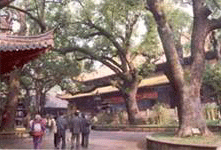 Puji
Temple (see left picture) is a compound of buildings. Its main hall housed
a huge statue of Quanyin Buddha at the center. Surrounding the wall were 32
representations (reincarnations) of Quanyin Buddha, sometimes male and sometimes
female, and each has a different outlook. Buddhas from the other three Buddhist
holy mountains (Earth Store Buddha from Mount Jiuhua, Puxian Buddha from Mount
Emei, and Manjushri Buddha from Mount Wutai) were also worshiped in a separate
hall. Thus there is a saying that, if you come to Mount Puto (and Puji Temple
in particular), then you've already come to all four holy mountains since
their Buddhas are represented here. There was also a Medicine Buddha hall
and a Five Hundred Arhat Hall, besides other smaller buildings that we did
not have time to explore.
Puji
Temple (see left picture) is a compound of buildings. Its main hall housed
a huge statue of Quanyin Buddha at the center. Surrounding the wall were 32
representations (reincarnations) of Quanyin Buddha, sometimes male and sometimes
female, and each has a different outlook. Buddhas from the other three Buddhist
holy mountains (Earth Store Buddha from Mount Jiuhua, Puxian Buddha from Mount
Emei, and Manjushri Buddha from Mount Wutai) were also worshiped in a separate
hall. Thus there is a saying that, if you come to Mount Puto (and Puji Temple
in particular), then you've already come to all four holy mountains since
their Buddhas are represented here. There was also a Medicine Buddha hall
and a Five Hundred Arhat Hall, besides other smaller buildings that we did
not have time to explore.
Buddhist Peak
 Our
next destination was to Buddhist Peak, the zenith of Mount Puto, and Huiji
Temple there. It only took five minutes of chair lift and a small walk to
get to the peak. Small shops lined up on two side of a street offering all
kinds of Buddhist items. It almost felt like Jiuhua Street. There were several
fine calligraphies along the path, some carved on rocks and some written on
walls. One calligraphy reads, "Together we get to the world beyond".
Buddhist peak offered an overview of the whole island, and a much smaller
island, Mount Luojia, was in viewing distance. Mount Luojia looked just like
a Buddha lying on the surface of the sea. As recorded in Buddhist scriptures,
Mount Luojia is the place Quanyin Buddha lives.
Our
next destination was to Buddhist Peak, the zenith of Mount Puto, and Huiji
Temple there. It only took five minutes of chair lift and a small walk to
get to the peak. Small shops lined up on two side of a street offering all
kinds of Buddhist items. It almost felt like Jiuhua Street. There were several
fine calligraphies along the path, some carved on rocks and some written on
walls. One calligraphy reads, "Together we get to the world beyond".
Buddhist peak offered an overview of the whole island, and a much smaller
island, Mount Luojia, was in viewing distance. Mount Luojia looked just like
a Buddha lying on the surface of the sea. As recorded in Buddhist scriptures,
Mount Luojia is the place Quanyin Buddha lives.
After paying respect and burning incense in Huiji Temple, our Qigong group walked down the hill by a different route instead of cable chair. On the way, we saw a few people bowing down every three steps (forehead touching stone steps) while walking uphill. These people are called "mountain respecters". This is a great Buddhist ritual to show the practitioner's respect and sincerity. Qigong Master Qinyin commented, "While their knees and foreheads may be rubbed to bleeding against stones, their diseases, even cancer, can be healed". When they bowed down in a complete circle, they were actually smoothing their microcosmic orbits (major meridians in the human body). While chanting Buddhas' names continuously in earnest with an empty mind, they connected to universal healing energy in a way that is similar or superior to the Qigong state.
Purple Bamboo Forest
 Once we were at the bottom of Mount Puto, our Qigong group took a bus to Purple
Bamboo Forest (left picture). It is written in Buddhist scriptures that Quanyin
Buddha often strolls in Purple Bamboo Forest. Bamboos are usually green. None
of us, except Qigong Master Qinyin, had seen purple bamboo before. Yet we
did. Although the leaves are still green, the stems are really purple, an
auspicious color.
Once we were at the bottom of Mount Puto, our Qigong group took a bus to Purple
Bamboo Forest (left picture). It is written in Buddhist scriptures that Quanyin
Buddha often strolls in Purple Bamboo Forest. Bamboos are usually green. None
of us, except Qigong Master Qinyin, had seen purple bamboo before. Yet we
did. Although the leaves are still green, the stems are really purple, an
auspicious color.
 In
the renowned Purple Bamboo Monastery (right picture), there was an unusual
Quanyin statue. Normally, Quanyin statues are gold-plated. But here is a white
Quanyin statue standing in front of a painting of purple bamboo forest. Quanyin
Buddha seemed to be very relaxed and graceful. She is at her home anyway.
In
the renowned Purple Bamboo Monastery (right picture), there was an unusual
Quanyin statue. Normally, Quanyin statues are gold-plated. But here is a white
Quanyin statue standing in front of a painting of purple bamboo forest. Quanyin
Buddha seemed to be very relaxed and graceful. She is at her home anyway.
Unwilling-to-leave Quanyin Temple
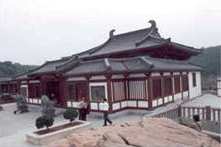 The
nearby Unwilling-to-leave Quanyin Temple (left picture) was rebuilt in 1980.
It is only steps away from the rocky coastline of the Pacific Ocean. This
temple was the first one on Mount Puto, initiated by the Japanese monk Huier.
In honor of Huier, the temple is now Japanese style among all other Chinese
style buildings on the island. Outside the temple, there is a corridor with
dozens of medium size Quanyin statues in windows, each of which was duplicated
from a temple in Japan that worships Quanyin Buddha. Maybe Quanyin Buddha
has been willing to leave China for Japan after all.
The
nearby Unwilling-to-leave Quanyin Temple (left picture) was rebuilt in 1980.
It is only steps away from the rocky coastline of the Pacific Ocean. This
temple was the first one on Mount Puto, initiated by the Japanese monk Huier.
In honor of Huier, the temple is now Japanese style among all other Chinese
style buildings on the island. Outside the temple, there is a corridor with
dozens of medium size Quanyin statues in windows, each of which was duplicated
from a temple in Japan that worships Quanyin Buddha. Maybe Quanyin Buddha
has been willing to leave China for Japan after all.
Chaoyin Cave
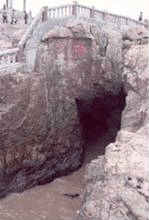 Just
below the Unwilling-to-leave Temple, is the famous Chaoyin Cave. "Chaoyin"
literally means "tide sound". The cave is about 20 meters deep,
and the entrance is partly submerged under the sea. It is said that Quanyin
Buddha used to practice in this cave, and there are still very strong Quanyin
signals until today. Qigong Master Qinyin told us that when she was studying
with Abbess Huikong (we were not able to meet with Abbess Huikong, Qigong
Master Qinyin's mentor, either because she preferred to be left alone or she
was visiting other parts of China), she often came to Chaoyin cave to practice.
Sometimes she could see images of Quanyin in the cave.
Just
below the Unwilling-to-leave Temple, is the famous Chaoyin Cave. "Chaoyin"
literally means "tide sound". The cave is about 20 meters deep,
and the entrance is partly submerged under the sea. It is said that Quanyin
Buddha used to practice in this cave, and there are still very strong Quanyin
signals until today. Qigong Master Qinyin told us that when she was studying
with Abbess Huikong (we were not able to meet with Abbess Huikong, Qigong
Master Qinyin's mentor, either because she preferred to be left alone or she
was visiting other parts of China), she often came to Chaoyin cave to practice.
Sometimes she could see images of Quanyin in the cave.
Things certainly have changed now. The sea level seems to be higher, and the government built fence to prevent visitors from entering the cave. Someone told us that before there were people who chose to die here on purpose, hoping that their spirits would be delivered by Quanyin Buddha to higher dimensions. Of course, Quanyin Buddha, who is full of love and compassion, doesnít want to see people seeking death at her home.
Unable to get into the cave, Qigong Master Qinyin asked us to calm down and enter the Qigong state. We closed our eyes slightly and opened our minds to receive Quanyin's signals. After a short while, Qigong Master Qinyin reminded us that there was a big Quanyin picture on the rock beside the cave. Most of us were able to see it. Eveline claimed that Quanyin Buddha gave her "shots". First a big one, followed by several small ones.
South Sea Quanyin Statue
 The
last scene that our Qigong group went to on Mount Puto was the landmark South
Sea Quanyin Statue, which can be seen almost from all over the island. It
is a huge statue in the open air, built as late as 1995. The statue is 18
meters high, made of bronze and gold. The body of the statue leans a little
bit forward, while Quanyin's eyes look downward full of compassion. Her left
hand holds a Dharma Wheel, and her right hand in the "no-fear mudra".
It is said that the day when it was initiated by leading monks at Mount Puto,
colorful lights cut through sky, which was overcast previously.
The
last scene that our Qigong group went to on Mount Puto was the landmark South
Sea Quanyin Statue, which can be seen almost from all over the island. It
is a huge statue in the open air, built as late as 1995. The statue is 18
meters high, made of bronze and gold. The body of the statue leans a little
bit forward, while Quanyin's eyes look downward full of compassion. Her left
hand holds a Dharma Wheel, and her right hand in the "no-fear mudra".
It is said that the day when it was initiated by leading monks at Mount Puto,
colorful lights cut through sky, which was overcast previously.
Abbess Talked about Buddhism
The night before we left Mount Puto, we came to have a final conversation with Abbess and Assistant Abbess of the nunnery. They had already prepared watermelons for us. Abbess gave each of us a bracelet, and Assistant Abbess gave each of us a necklace to create karma with us.?Before giving the bracelets to us, Abbess waved her palm near them. She didn't explain anything, but I knew she was energizing or initiating these bracelets. When I put on mine, I immediately felt the energy and even heat. Qigong Master Qinyin asked Abbess to explain what are the benefits of enlightenment. Abbess is an amiable person, and she delivered abstract Buddhist teachings through interesting stories. She talked about Puxian Buddha's Ten Great Wishes, which is one way of practicing Buddhism. Eveline, who grew up as a catholic, blurted out , "It is too late for me to change my belief system". Abbess explained that Buddhism and Christianity were not necessarily in conflict. Occasionally she listened to Christian radio and found some of their teachings sensible too.
Conclusion
It is not surprising that the renowned Spirits' Retreat Temple was built by a missionary Indian monk. But what amazes me is that two of China's four Buddhist holy mountains actually got started by monks from Korea and Japan, who came to China to learn Buddhism. At those times, China was certainly more confident and open than in the past few centuries. Fortunately, since 1978, China has once again become open. Buddhism, Daoism and their holy mountains are now undoubtedly on the rise.
As our Qigong group reflected on this poignant journey, each could recall a significant moment that impressed them. Myra (aged 71) shared: When I first arrived at Qiyuan Temple, although I had felt some energy, I could not climb the four flights of stairs to my room without stopping to catch my breath. When we were ready to leave, I rushed up those stairs two at a time so fast I didn't even realize I had reached the 4th floor! Maybe Barbara, another Qigong student, summarized the feeling of our whole group, I came away from this whole journey looking a little younger and feeling better.
Last update 08/19/07.